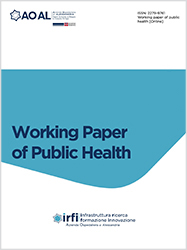The role of mismatch repair proteins expression in colorectal cancer

All claims expressed in this article are solely those of the authors and do not necessarily represent those of their affiliated organizations, or those of the publisher, the editors and the reviewers. Any product that may be evaluated in this article or claim that may be made by its manufacturer is not guaranteed or endorsed by the publisher.
In the present study, carried out during the internship in Surgical Pathology of Santo Spirito Hospital in Casale Monferrato, a score based on the quantification of mismatch repair proteins (MMR) in patients with colorectal adenocarcinoma was devised, to determine whether a different expression in these proteins could correlate with some morphological parameters, and therefore whether it was possible to define a prognostic stratification for these patients.
Objective During this period, 73 cases of colorectal adenocarcinoma referred from 01/01/2020 to 31/03/2021 were analyzed. The cases were investigated by immunohistochemical examination to assess the expression of mismatch repair proteins. Subsequently, the immunohistochemical preparations were observed by light microscopy, evaluating a total percentage of expression in the tumor tissue, in order to perform a correlation study between the expression of mismatch repair proteins and some morphological characteristics of the tumor at diagnosis. The total expression of MLH1 protein, as representative of the MLH1/PMS2 heterodimer, and of MSH6 protein, as representative of the MSH2/MSH6 heterodimer, was quantified.
Methodology Evaluation of microsatellite instability was obtained by immunohistochemical investigation using ROCHE's automated VENTANA Bench-Mark Ultra platform. Correlation study, between tumor morphological data at diagnosis and expression of mismatch repair proteins, was performed by use of parametric and nonparametric tests.
Results Total expression of MSH6 protein was higher than MLH1 expression in 60 of 73 cases. MSH6 protein is more frequently associated with high expression (from 75% to 100%) than MLH1, which is characterized by a lower expression range. The correlation test of MLH1 expression per- centage with perineural invasion gave a statistically significant results, with a p-value below the limit of significance (p=0.007191). In the case of MSH6, statistically significant p-values were shown for tumor budding (p=0.02577), perineural invasion (p=0.007498) and growth margin (p=0.04664).
Conclusions Quantifying MMR protein expression in MSS tumors could be a valuable aid in therapeutic choice, as well as in prognostic stratification of MSS patients between subjects with high expression, and thus less aggressive tumors, and subjects with low expression lesions of MLH1 and/or MSH6, and thus more biologically aggressive tumors. If a different expression in mismatch repair proteins correlates with morphological characteristics of greater or lesser malignancy, it could be hypothesized that patients with MSS colorectal cancer, treated with the same therapy, may have a greater or lesser response, depending on the percentage of expression of mismatch repair proteins, estimating a more effective adjuvant therapeutic response in subjects with high expression.
PAGEPress has chosen to apply the Creative Commons Attribution NonCommercial 4.0 International License (CC BY-NC 4.0) to all manuscripts to be published.

 https://doi.org/10.4081/wpph.2021.9430
https://doi.org/10.4081/wpph.2021.9430




